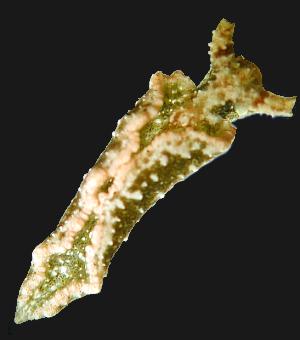
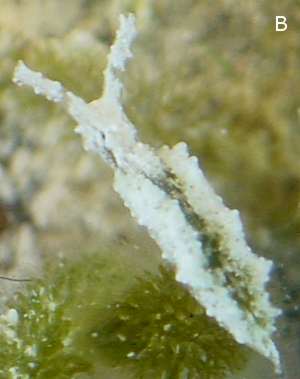
Elysia papillosa
Verrill, 1901
Order: SACOGLOSSA
Superfamily: ELYSIOIDEA
Family: Elysiidae
DISTRIBUTION
Known only from Florida and Bermudas.
PHOTO
Upper: Florida Keys, USA., in shallow water in association with multiple Caulerpa species. 7mm long. Photo: Anna L. Bass. Lower: Great Exuma, Bahamas, Western Atlantic. Site: Stocking Island, Hole n°2. 5 February, 2004. Depth: 1m. Size: 5-6mm. Photo: Marina Poddubetskaia.
Kerry Clark (1994) considered that this 'species' may in fact be a collection of cryptic or sibling species. As its name suggests this species is characterised by the papillae, usually white, which cover most parts of the animal except the sole of the foot. This species is pale green with a broad whitish band along the parapodial edge. The head is often white, The pericardium is brownish, and there can be white blotches on the inside of the parapodia. Along the parapodial edge there is a line of brownish granules which in larger specimens can coalesce into a distinct dark line. It has been reported (Clark, 1984) to feed on algae of the genera Halimeda and Penicillus and Udotea flabellum.
See Phanor Montoya's message with a possible record from Colombia.
References:
• Clark, K.B. (1984) New records and synonymies of Bermuda opisthobranchs (Gastropoda). The Nautilus, 98(2): 85-97.
• Clark, K.B. (1994) Ascoglossan (Sacoglossan) Molluscs in the Florida Keys: Rare marine invertebrates at special risk. Bull. Mar. Sci. 54(3): 900-916.
• Redfern. C., 2001. Bahamian Seashells: a Thousand Species from Abaco, Bahamas.
• Verrill, A.E. (1901) Additions to the fauna of the Bermudas. Trans. Connecticut. Acad., 11 (1901-03) pt. 1(2): 15-62, pls 1-9.
Rudman, W.B., 2001 (January 13) Elysia papillosa Verrill, 1901. [In] Sea Slug Forum. Australian Museum, Sydney. Available from http://www.seaslugforum.net/find/elyspapi
Related messages
Triad rhinophores of Elysia
May 12, 2009
From: Deng Yan Zhang
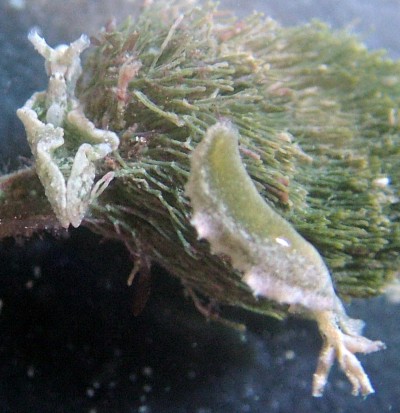
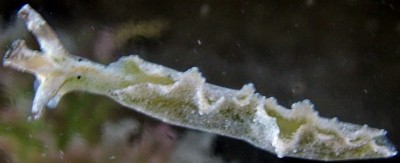
Concerning message #17468:
Dear Bill,
This is a interesting Elysia with triad rhinophores. In March 29, 2009 from Antigua I was found in lower tide 0.2 m water, gravel bottom with Penicillus capitatus and Udotea sp. and Halimeda sp.
Locality: St John;s, 0.2 m, Antigua, Caribbean sea, 29 March 2009, lower tide gravel bottom . Length: 14 mm. Photographer: D. Y. Zhang.
The animal with triad rhinophores is 14 mm, with purplish-brown rings on the rhinophores, in picture another one found in same time at the same area and about similar size, but its without purplish-brown rings on the rhinophores and main colors are green with white vesicles. I am not sure whether it is Elysia papillosa or E. patina? Any directions are welcome.
Best regards,
Deng Y. Zhang
kejushi@hotmail.com
Zhang D.Y., 2009 (May 12) Triad rhinophores of Elysia. [Message in] Sea Slug Forum. Australian Museum, Sydney. Available from http://www.seaslugforum.net/find/22424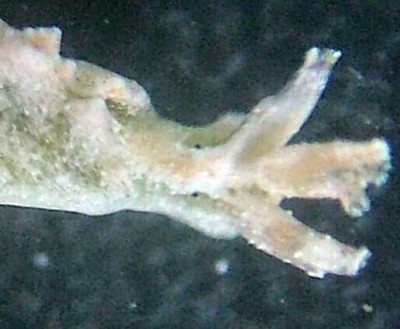
Dear Deane,
Another animal to add to the Abnormalities page.
Concerning its identity. As you will see from earlier messages, I am of the opinion that E. patina is unidentifiable since the original description was inadequate. Kathe Jensen discusses the possibility that E. papillosa is really a complex of similarly coloured species. Even if that proves correct it would be confusing to use the name 'E. patina' for one of the unnamed species. If we can't identify it now we shouldn't consider it to be available for use just because we are short of a name.
Best wishes,
Bill Rudman
Re: Elysia patina from Florida
August 26, 2006
From: Kathe R. Jensen
Concerning message #17468:
Dear Skip and Bill,
I can only say that the animals Kerry and I identified as Elysia patina in Florida were a lot darker green in color, but obviously that is not a good character. And, Skip, I am also confused about E. papillosa and E. patina - in fact this was a discussion that Kerry and I never finished (so maybe I will get the final say?). It is difficult to see pericardium and dorsal vessels in these pictures, but the dorsal vessels and the "gametolytic vesicles" were the main external features we used for identification. I don't remember the radular teeth, but I do remember that "E. patina" was collected on Udotea and E. papillosa on Penicillus - but I think that both would feed on both algae in the lab. The present animal(s?) seems to have a brown band on the rhinophores, which is usually seen in E. papillosa. On the other hand, the low, warty papillae are not like the ones I remember from E. papillosa.
Bill, your explanation about "gametolytic vesicles" is correct, except that I have never seen them disappear once they were formed - but maybe I haven't kept the animals long enough to empty their sperm stores.
Best wishes,
Kathe
krjensen@snm.ku.dk
Jensen, K.R., 2006 (Aug 26) Re: Elysia patina from Florida. [Message in] Sea Slug Forum. Australian Museum, Sydney. Available from http://www.seaslugforum.net/find/17610Thanks Kathe,
Bill Rudman
Elysia patina from Florida
August 25, 2006
From: Sidney Pierce
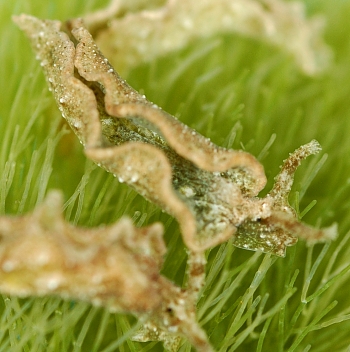
Hi Bill
Attached are a couple of pictures (taken by my post-doc, Nick Curtis and colleague Ray Martinez) of one of several specimens of an Elysia that crawled out of Penicillus capitatus that I collected at Sunset Beach, Tarpon Springs, FL. They were either juveniles or an unnoticed egg mass when collected. They appeared in our lab aquaria a couple of weeks after the algae had been collected. I was collecting the algae for food for Elysia clarki, which does not occur as far north as Tarpon Springs. I've seen these guys before, but never paid too much attention to them as they are too small and too few for us to work on. We always have glibly identified them as Elysia papillosa. However, I'm wondering about that identification. I've looked at Verrill's original description (Verrill is a hero to me, by the way) and the Tarpon Springs specimens do not match his brief description of E. papillosa very well (except that they do swim!!) nor his drawing-even assuming some artistic license-(nor the Marcus' cartoons) nor do they look much like some of the pictures identified as E. papillosa on the Forum, especially some of those from the Bahamas. On the other hand, other Forum photos, in the E. papillosa group (eg. Anna Bass', K. Archer's, maybe Montoya's-from various sites in the Bahamas and Caribbean) look just like the Tarpon Springs slugs. Since Verrill's description of E. papillosa was based on ("rare") specimens from Bermuda and seems to be a closer match to some of the Bahamas photos-I initially thought the Tarpon Springs slugs might be a new species. However, I was watching some swim the other day and as the parapodia flailed away, two "gametolytic vesicles" were uncovered on the dorsal surface (see the photo). I have no idea what gametolytic vesicles are in a functional sense, but there are not many species of Elysia that have them-and E. papillosa does not as near as I can tell. Of those species that seem to have that structure, only the elusive E. patina, which Marcus described from a single specimen collected in the Keys, seems to fit (Jensen and Clark (1983) also reported collecting some at Key Largo, subsequent to Marcus' (1980) description, mostly without comment). I agree with your comments about the problems caused by describing a new species on the basis of a single, preserved specimen, which is exactly what Marcus did in this case. But maybe she was right?? What do you think??
By the way, these guys do eat and grow very rapidly on Penicillus capitatus (which is the alga in the picture) and, if they have a chloroplast symbiosis, it does not last long-maybe a week or two. You and others have noted that Kerry Clark predicted that E. papillosa was likely composed of more than one species - maybe E. patina is part of the confusion?? Or maybe I'm confused.
Locality: Sunset Beach, Tarpon Springs, just subtidal, Florida, USA, Gulf of Mexico, many times throught the year, on Penicillus capitatus. Length: 5-7mm. Photographer: Nick Curtis and Ray Martinez.
Skip
pierce@cas.usf.edu
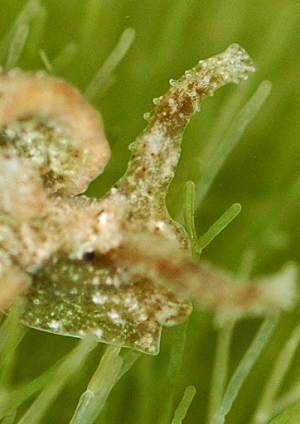
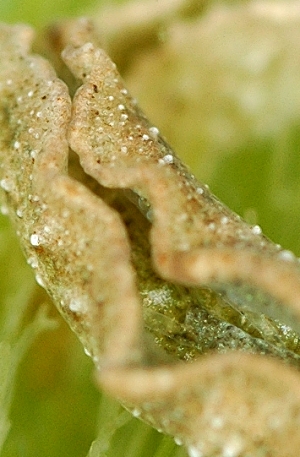
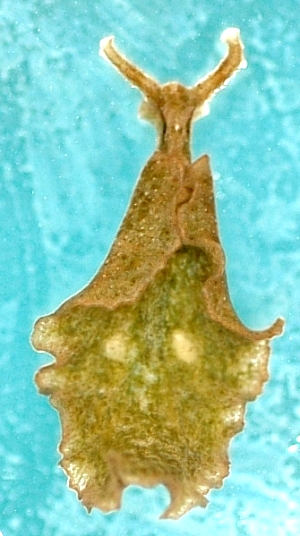
Dear Skip,
As I said earlier [message #7929 ] I am sure there will be many wasted hours spent trying to determine the indentity of E. patina. I can't see why it was necessary to give one preserved specimen a scientific name. Your animals may be her E. patina but until the Elysia species of the Caribbean is reviewed as a group, rather than one by one, I suspect confusion will continue. Concerning "gametolytic vesicles" [see two white structures in photo alongside] I assumed these are temporary structures produced by species which fertilise each other by hypodermic injection. Rather than use a female vaginal opening, ther are some species of sacoglossan which have a stylet on the tip of the penis with which they inject their sperm into the partner, straight through the body wall. In some species there seems to be a favourite spot in which to inject, while in others it seems to be fairly random. After the sperm is injected inot the body cavity, a sac [the gametolytic vesicle] forms around the sperm mass, but from there just how the sperm gets to the unfertilise eggs is a bit of a mystery to me. Perhaps Kathe can enlighten us.
However since I thought the gametolytic vesicles were temporary structures able to be produced when neede, at different places, they don't seem to be a good taxonomic character. Perhaps in some species they always form at the same place?
I was going to put your species on an 'unidentified page' but I think I wiull put it on the E. papillosa page, so that it remains part of the discussion.
Best wishes,
Bill Rudman
Elysia papillosa from the Bahamas
September 12, 2005
From: Anne DuPont
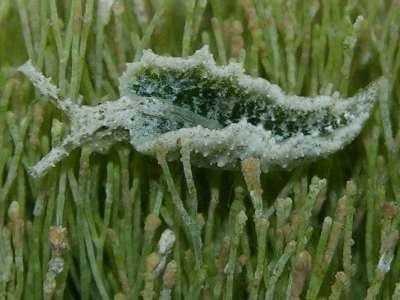
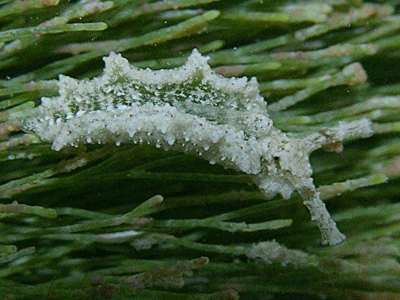
Dear Bill,
Here is a photo of an Elysia papillosa that I found in the same bay with the Elysia species [message #14645]. It was found on Penicillus dumetosus or P. capitatus.
Location: Stocking Island, Exumas, Bahamas, 8 feet of water, 19 December 2004. Approximately 8 mm.
Thank you,
Anne DuPont
Delray Beach, FL
akdupont@bellsouth.net
DuPont, A., 2005 (Sep 12) Elysia papillosa from the Bahamas. [Message in] Sea Slug Forum. Australian Museum, Sydney. Available from http://www.seaslugforum.net/find/14653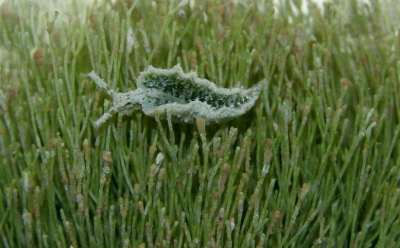
Dear Anne,
I think, from all your photos, that I am almost getting a feel for this wonderful diversity of sacoglossans you have in the Caribbean.
Best wishes,
Bill Rudman
Re: Elysia papillosa from Cape Verde Islands
March 5, 2004
From: Kathe R. Jensen
Dear Bill,
Concerning the Elysia from Cape Verde Islands [#10757], I am afraid that I cannot identify this animals with any certainty. Also, I looked at the Fact Sheet for Elysia papillosa, and I am fairly certain that Jeff Hamann's animal on seagrass [#8204] is Elysia subornata (= E. cauze). Anna Bass' animal with the brownish rings on the rhinophores is definitely E. papillosa. Incidentally, the Marcuses described a highly papillose form of E. subornata as E. cauze scoops, and it is possible that Gérard's animal is that species.
Greetings,
Kathe
krjensen@zmuc.ku.dk
Jensen, K. R., 2004 (Mar 5) Re: Elysia papillosa from Cape Verde Islands. [Message in] Sea Slug Forum. Australian Museum, Sydney. Available from http://www.seaslugforum.net/find/10846Thanks Kathe,
I must say that with your commentary, and the help of all those who have sent in photos over the last few years, we seem to be getting a clearer picture of the elysiids of the Caribbean. I will remove the misidentified photos from the E. papillosa Fact Sheet. In all the remaining photos I can see a distinct transparent/colourless band near the base of each rhinophore. Is this a constant character of this species? If so, it would seem to be a be a useful way to separate it from other papillose species.
Best wishes
Bill Rudman
Elysia papillosa from Southern Bahamas
March 5, 2004
From: Marina Poddubetskaia
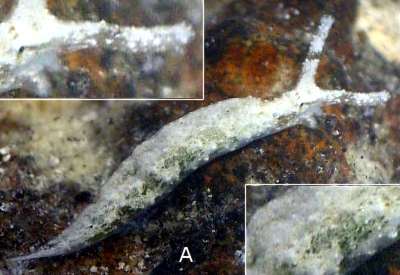
Dear Bill,
Here is another Elysia from the Bahamas: I think it is Elysia papillosa and I'd like to have this ID confirmed. In Exuma, Anne DuPont and I saw several specimens of this species. All of them were found on the 'brush alga' which you identified as Penicillus [see photo in separate message #12334]. Most of these specimens were really tiny (about 5mm) and very difficult to photograph. So, sorry for the poor photos.
A: February 06, 2004. Great Exuma, Bahamas, Western Atlantic. Site: Stocking Island, Hole n°0. Depth: 2m. Size: 12mm.
B: February 05, 2004. Great Exuma, Bahamas, Western Atlantic. Site: Stocking Island, Hole n°2. Depth: 1m. Size: 5-6mm.
C: February 01, 2004. Great Exuma, Bahamas, Western Atlantic. Site: Stocking Island, Hole n°2. Depth: 2.5m. Size: 3-4mm
Photos: Marina Poddubetskaia - Nembro website
Thank you in advance for your help.
Best wishes,
Marina.
nembro@nembro.info

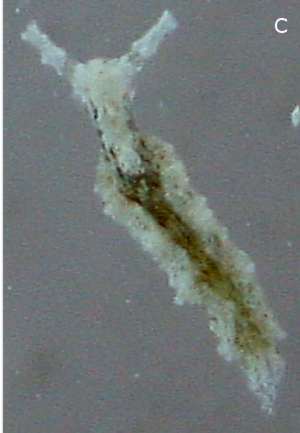
Dear Marina,
I am not the world expert on Elysia but I am pretty sure you are right in thinking all these are Elysia papillosa. I noted in all your animals there is a transparent band on the rhinophores, which may turn out to be a useful distinguishing character for the species. I have asked Kathe Jensen for her opinion
Best wishes
Bill Rudman
Elysia papillosa - algal food
March 5, 2004
From: Marina Poddubetskaia
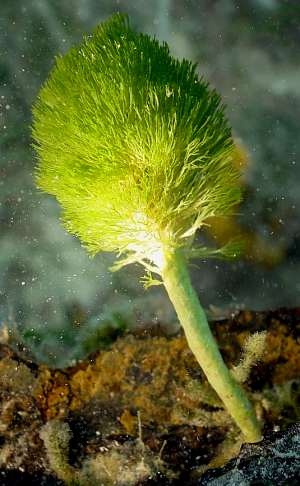
Dear Bill,
This is the alga we found the Elysia papillosa on, which are photographed in our separate message #12333. This 'brush alga' is what you previously identified as Penicillus. Most of these specimens were really tiny (about 5mm)
February 06, 2004. Great Exuma, Bahamas, Western Atlantic. Site: Stocking Island. Photo: Marina Poddubetskaia
Best wishes
Marina Poddubetskaia
nembro@nembro.info
Poddubetskaia, M., 2004 (Mar 5) Elysia papillosa - algal food. [Message in] Sea Slug Forum. Australian Museum, Sydney. Available from http://www.seaslugforum.net/find/12334Thanks Marina,
Yes this is a species of Penicillus, but I will need some help with the species identification.
Best wishes
Bill Rudman
Elysia papillosa from Northern Bahamas
March 5, 2004
From: Marina Poddubetskaia
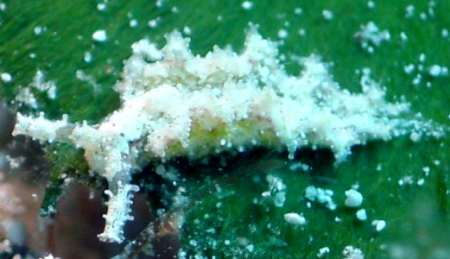
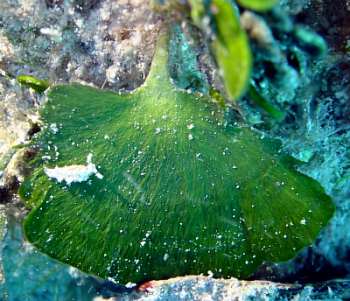
Dear Bill,
During my diving cruise in Northern Bahamas I was amazed to find Elysia papillosa on an alga different from its usual Penicillus [see message #12334]. I saw only one specimen on this alga, so it could be a coincidence.
Bimini Islands, Bahamas, Western Atlantic. Site: Bimini Road. Depth: 4m. Size: 8mm. February 12, 2004. Photos: Marina Poddubetskaia - Nembro website
Cheers,
Marina.
nembro@nembro.info
Poddubetskaia, M., 2004 (Mar 5) Elysia papillosa from Northern Bahamas. [Message in] Sea Slug Forum. Australian Museum, Sydney. Available from http://www.seaslugforum.net/find/12335Thanks Marina,
Kerry Clark (1984) reports that this species feeds on algae of the genera Halimeda, Penicillus and Udotea flabellum. All these alage are related, and have some degree of calcification. The alga in your photo is a species of Udotea, so it is most likely it was on it by choice rather than chance
Best wishes
Bill Rudman
Elysia papillosa from Cape Verde Islands
August 26, 2003
From: Gérard Breton
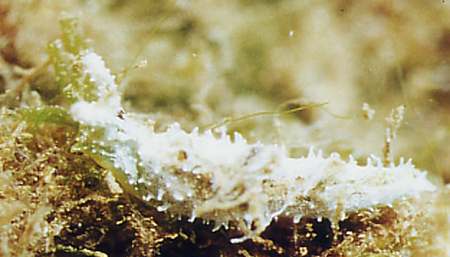
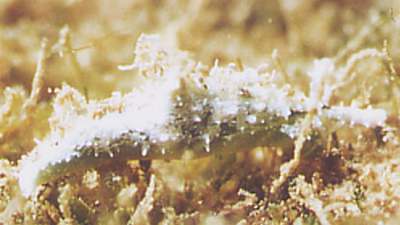
Dear Bill,
Here is another message from my dive trip between 22 - 30 March 2003 to two islands of the Cape Verde archipelago: Sal and Fogo.
Here are some photos of Elysia papillosa from Sal, Palmeira natural harbour, - 1m, grazing on tiny filamentous algae and diatoms.
Gérard Breton
Gerard.Breton@ville-lehavre.fr
Breton, G., 2003 (Aug 26) Elysia papillosa from Cape Verde Islands. [Message in] Sea Slug Forum. Australian Museum, Sydney. Available from http://www.seaslugforum.net/find/10757Thanks Gerard,
It certainly looks like E. papillosa from the Caribbean, but as we have recently seen with Elysia tomentosa there are a number of species with papillae like this and identifying them is quite a problem. Perhaps Kathe Jensen will be able to confirm the identification for us
Best wishes,
Bill Rudman
Re: Elysia from Florida
January 18, 2002
From: Kathe R. Jensen
Dear Colin & Bill,
I looked at the paper of Ortea & Espinosa that Colin mentioned, and their Elysia pratensis described from Mexico does look similar to what I remember seeing in the Florida Keys some 20 years ago. However, I don't remember any yellow or orange pigment on the tips of the rhinophores. Nor do I remember the white spots on the inner margins of the parapodia. Do you find these characters in specimens from the Bahamas? I can't remember what the dorsals vessels were like (and I don't have my Florida notebooks with me in Thailand), but the radular teeth were also similar to those figured by Ortea & Espinosa.
• Ortea, J. & Espinosa, J. 1996. Descripcion de una nueva especie del genero Elysia Risso, 1818 (Opisthobranchia: Sacoglosa) recolectada en Puerto Morelos, Mexico. Avicennia, 1996, 4/5: 115-119. (sorry my keyboard doesn't have all the Spanish accents)
Greetings,
Kathe
jensen@ait.ac.th
Jensen, K.R., 2002 (Jan 18) Re: Elysia from Florida. [Message in] Sea Slug Forum. Australian Museum, Sydney. Available from http://www.seaslugforum.net/find/6023Re: Elysia from Florida
January 17, 2002
From: Colin Redfern
Dear Dr. Rudman,
I was interested to read several recent messages on the Sea Slug Forum concerning Elysia papillosa. This is a common species in the northern Bahamas, where some specimens closely resemble the animals figured recently by Kathleen Archer. However, this is a very variable species, and it's worth noting that Kerry Clark (1994, Bulletin of Marine Science) suggested that several sibling species may have been referred to as E. papillosa. Also occurring in the Bahamas is Elysia pratensis Ortea & Espinosa, 1996, which is probably the striped species referred to by Kathe Jensen in her message of January 13.
Best regards,
Colin Redfern
bahamianseashells@att.net
Redfern, C., 2002 (Jan 17) Re: Elysia from Florida. [Message in] Sea Slug Forum. Australian Museum, Sydney. Available from http://www.seaslugforum.net/find/6001Dear Colin,
Thanks for your input. It is nice to hear from a resident of the region with a familiarity with the fauna. There are clearly many taxonomic puzzles in the west Atlantic / Caribbean fauna. I am more than happy to post photos of any sea slugs from the region showing colour variations etc as an aid to further research.
Best wishes,
Bill Rudman
Re: Elysia from Florida
January 13, 2002
From: Kathe R. Jensen
Dear Bill and Kathleen,
I am almost certain that Kathleen's animal is Elysia papillosa. The brownish band on the rhinophores is very distinctive for this species. As far as I remember we did not collect E. patina from Penicillus when I was in Florida, and the only other species feeding on Penicillus is a distinctly striped one, which may be either an undescribed species or a variety of E. subornata (indicated by electrophoresis done by one of Kerry Clarks's Ph.D. students, but never published).
Elysia papillosa has lecithotrophic development, i.e. veligers that do not swim very far and do not need to feed before metamorphosis. Probably your Penicillus had an eggmass, which hatched when it arrived in your lab. Most sacoglossans are about 0.7mm when they settle, and given a good food supply they could grow to about 10mm in a few weeks. You could also have had the juveniles already in the algae when you received them, but if they had been feeding, the alga would probably have shown some damage within the first couple of days. Algal filaments are weakened by the piercings of the cell wall, so even if juvenile sacoglossans do not extract a visible amount of cytoplasm, they still make structural damage to the cell wall.
Cheers,
Kathe
jensen@ait.ac.th
Jensen, K. R., 2002 (Jan 13) Re: Elysia from Florida. [Message in] Sea Slug Forum. Australian Museum, Sydney. Available from http://www.seaslugforum.net/find/5967Elysia from Florida
January 12, 2002
From: Kathleen Archer
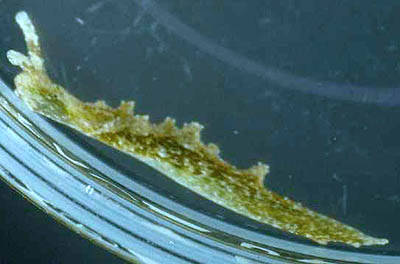
Hi Everyone,
I am culturing the macroalga Penicillus, and began by purchasing specimens from Carolina Biological. I believe the specimens were collected in the Florida Keys. About 4 weeks after planting the alga in an aquarium tank, there appeared a number of sea slugs. They grew in size, which suggested to me they must be feeding on something in the tank. The algal culture is not pure, and there are a number of other algae growing.
The slugs are a nice green color, and since I am interested in slugs which retain chloroplasts from the algae they eat I would like to know what it is. It looks the most like Elysia papillosa, although the papillate projections from the parapodia aren't quite like those in the photograph posted on the Forum. The slugs are about 10 - 15 mm long. If anyone can suggest an identification I would be most grateful. Thanks for your help,
Kathleen Archer
kathleen.archer@trincoll.edu
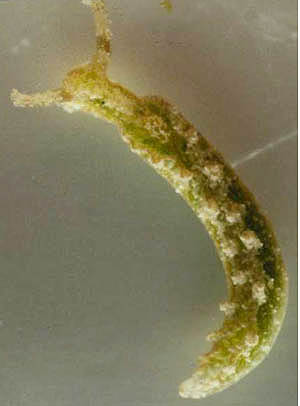
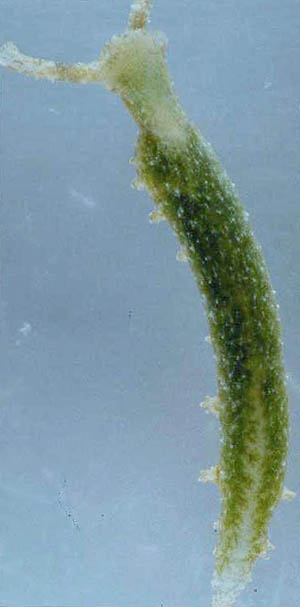
Dear Kathleen,
Eveline Marcus (1980) published a review of the Caribbean Elysiidae but I find it very difficult to use, and lacks good descriptions of the shape and colour of the living animals. The only character comprehensively reviewed is the branching of the dorsal vessels on the inside (dorsal) wall of the parapodia. Your animal has some fairly distinctive characters in shape and colour and appears to have tubercles on the renopericardial swelling so hopefully someone familiar with the fauna should be able to identify it for you.
Kathe Jensen (1983) does record Elysia papillosa preferring Penicillus capitatus and Halimeda tuna so you could be on the right track.
• Jensen, K.R. (1983) Factors affecting feeding selectivity in herbivorous ascoglossa (Mollusca: Opisthobranchia). J. Exp. Mar. Biol. Ecol. 66: 135-148.
• Marcus, Ev (1980) Review of western Atlantic Elysiidae (Opisthobranchia Ascoglossa) with a description of a new Elysia species. Bulletin of Marine Science, 30(1): 54-79.
Good Luck with your research. Hopefully we can have your animal identified soon
Best wishes,
Bill Rudman.
Elysia papillosa from Florida
January 13, 2001
From: Anna L. Bass

Hello Dr. Rudman,
I wanted to send you these photos of E. papillosa. The larger and colored specimen (upper & lower right photos) is 7 mm in length. My notes indicate that the renopericardial prominence is only 1/3 the length of the body and there are 4 main branches arising from the prominence (3 in a lateral direction and 1 in an posterior direction). In addition there were two vesicles located on the upper parapodium surface and lateral to the posterior vessels. I believe the lower left photo to be a juvenile of this species (3 mm in length).
Both animals were found in the Florida Keys in shallow water and in association with multiple Caulerpa species.
Best Regards,
Anna L. Bass
abass@helios.acomp.usf.edu
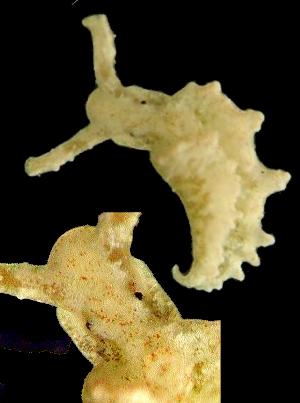
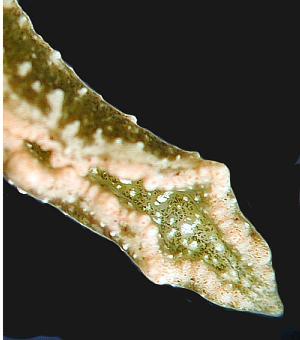
Thanks Anna,
There seem to be small orange-red spots along the parapodial edge in the adult (lower right photo) and on the head in the juvenile. Are they characteristic of the species?
Best wishes,
Bill Rudman.
With regards to Elysia papillosa
October 16, 2000
From: Phanor Montoya
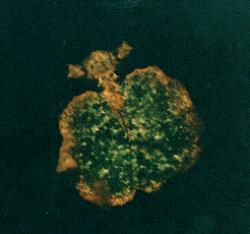
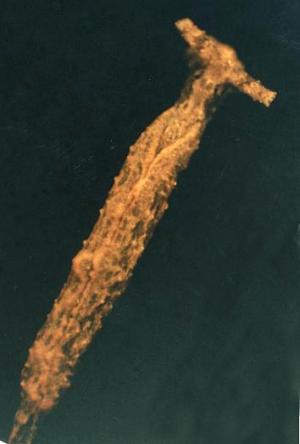
Dear Bill:
As always thanks for your invaluable help.
I'm sending another foto of what you identified as Elysia papillosa. It might help you confirm the identification.
I am sending you another Elysia sp. collected from the same area as E. papillosa. This species differs from E. papillosa since it does not have a yellow margin and is bigger - 10-15mm.
Sincerely yours,
Phanor
phamont@eudoramail.com
Montoya, P., 2000 (Oct 16) With regards to Elysia papillosa. [Message in] Sea Slug Forum. Australian Museum, Sydney. Available from http://www.seaslugforum.net/find/3141Dear Phanor,
You will see Kathe Jensen's message today. Perhaps she can confirm my idea and identify the other one.
Best wishes,
Bill Rudman
Re: Elysia from Colombia
October 16, 2000
From: Kathe R. Jensen
Dear Bill & Phanor,
The other possible ID for this Elysia is E. patina Marcus, 1980, which almost certainly feeds on Udotea. There has been some controversies about distinguishing E. papillosa and E. patina, but I think that E. patina has a long renopericardial prominence with many pairs (>6) of branching dorsal vessels, whereas E. papillosa has a short renopericardial prominence with few (<=4 pairs) dorsal vessels. The radular teeth also differ in shape, but this is where I had a disagreement with Kerry Clark, because my old radular mounts (for light microscopy) of E. papillosa teeth showed straight blades with coarse denticles, whereas Kerry describes narrow, curved or hooked teeth in Bermudan specimens collected from Halimeda. This is also the shape that I found in E. patina from Florida. Plasticity in tooth shape has been described in other sacoglossans, so this may not be a good distinguishing character in this case.
The egg mass may or may not be of this Elysia species. As far as I remember, E. papillosa has eggs with white extra-zygotic yolk. I cannot remember if E. patina has extrazygotic yolk, but as it has planktotrophic development, I doubt it. The eggs look more like those of the Halimeda-feeding E. tuca Marcus & Marcus, 1967.
Greetings,
Kathe
jensen@ait.ac.th
Jensen, K.R., 2000 (Oct 16) Re: Elysia from Colombia. [Message in] Sea Slug Forum. Australian Museum, Sydney. Available from http://www.seaslugforum.net/find/3173Thanks Kathe,
Not an easy job to identify some species of Elysia from photos, especially when their taxonomy is still in some doubt. One problem I have found with old light microscope radular preparations is that the refractive index of the mounting medium can have a considerable affect on how denticles appear to even the most diligent observer. Because of the way light is curved by the interface between different media, in this case the glass, the mounting medium and the radula 'tissue', once a denticle, or other structure, becomes very thin it begins to appear very coarse to the viewer because the interface appears to be the object. In fact at a certain stage fine denticles appear as very coarse denticles. Really the only way to determine whether denticles are fine or coarse is to start again with a scanning electron microscope.
Best wishes,
Bill Rudman.
Elysia from Colombia
October 8, 2000
From: Phanor Montoya
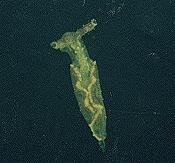
Dear Bill:
I found this Elysia in a soft bottom (Santa Marta, Colombia) cover with seagrass (Halophila sp) and the algae Udotea sp and Dictyota sp. It was 4-5 mm long and was found commonly on Udotea spp. Also on this algae I found the egg masses that I'm sending you. I think they belong to the Elysia sp.
Phanor
phamont@eudoramail.com
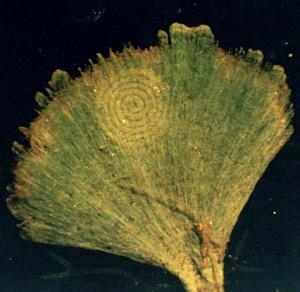
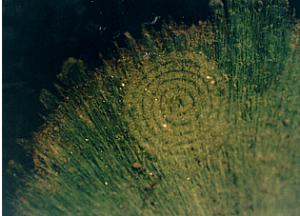
Dear Phanor,
I am not familiar with the Caribbean fauna but this animals looks very like the one Kerry Clark (1984) identified as Elysia papillosa Verrill, 1901. I can see the papillae in your photo and the broad white band along the parapodial edge. But only some one familiar with the Caribbean fauna will be able to confirm the identity.
Concerning the egg masses. The egg spirals could belong to the Elysia but unfortunately, the only way to be sure who produced them would be to watch them being laid.
Reference: Clark, K.B. (1984) new records and synonymies of Bermuda opisthobranchs (Gastropoda). The Nautilus, 98(2): 85-97.
Best wishes,
Bill Rudman.
